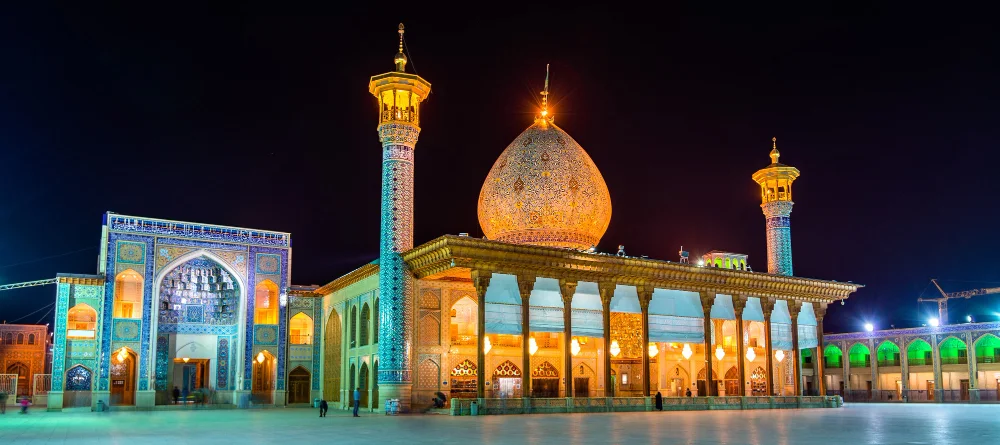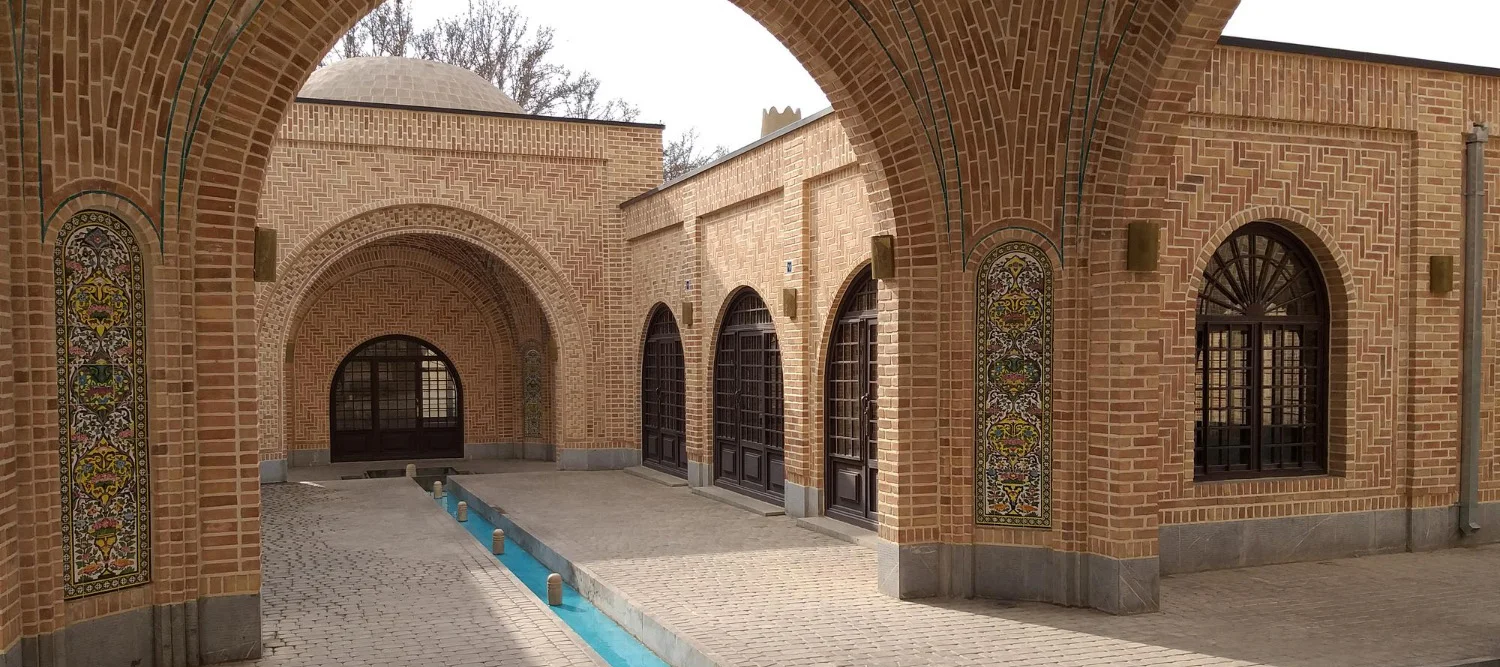
Shah Cheragh
Shah Cheragh stands as a remarkable blend of religiosity and tourism within Shiraz, the cultural heart of Iran. With accessible air travel options, individuals can easily journey to Shiraz, where they have the opportunity to explore this vibrant intersection of culture and faith. This grand and splendid shrine is dedicated to Imamzadeh Ahmed bin Musa. Celebrations are kindled during Karamat Week, coinciding with the commemoration of Ahmad Musa (AS), the brother of Imam Reza. Spanning from Hazrat Masoumeh's birth to Hazrat's own birth, this week hosts a plethora of festivities and rituals, harmonizing with the Sha'ban holidays observed throughout Iran.
On the 6th of Dhul-Qa'da, the city of Shiraz radiates with jubilation as it honors the memory of Ahmad bin Musa. The Shah Cheragh Shrine becomes a focal point for these joyous celebrations. Imamzadeh Ahmad bin Musa, the firstborn of Imam Musa (AS) and Umm Ahmad (Saeedah Khatoon), has etched his presence within this shrine, now standing as an emblem of Shiraz's allure for tourists and pilgrims alike.

Discover The Following Topics In This Engaging Article:
- The biography of Imamzadeh Ahmad bin Musa (Shahcharagh)
- The reason for the title of Imamzadeh Ahmad bin Musa
- The architecture of Shahcharagh
- The history of the construction of the Shahcharagh tomb
- How many people are there in Shahcharagh Shiraz?
- Places near Shahcheragh Shiraz
1. The biography of Imamzadeh Ahmad bin Musa (Shahcharagh)
When Imam Reza (a.s.) reluctantly accepted the imposed rule of Ma'mun Abbasi, he was compelled to leave his residence in Medina and migrate to Khorasan. During this era, Tus and Khorasan served as the centers of power for the Ma'mun Abbasi dynasty, a ruling house that strategically adopted an Iranian lineage to gain favor among the Iranian populace. Following his migration, the family of Imam Reza (a.s.) embarked on a journey to reunite with him in Khorasan, encountering distinct challenges along the way.
During this journey, Ahmed bin Musa, who resided in Hijaz at the time and was actively involved in religious pursuits, made the decision to represent his brothers and visit Imam Reza (AS) on their behalf. Word of this intended visit reached the agents of the Abbasid government, who promptly informed Ma'mun.
Aware of Ahmad bin Musa's substantial popularity among both Iranians and Arabs, Ma'mun Abbasi felt threatened by the pervasive influence of Imam Reza (a.s.). Seeking to curb their impact, he issued orders to eliminate Ahmad bin Musa before he could reach Khorasan. Fearing his own grip on the caliphate might be undermined, Ma'mun also commanded the caravan of Bani Hashem to halt and return to Medina. As a result of this directive, Ahmad bin Musa, also known as Shah Cheragh, altered his route to Khorasan by way of Shiraz.

Upon arriving in Shiraz, the ruler of the city, "Qatlugh Khan," positioned his forces comprising 40,000 soldiers approximately eight miles outside Shiraz in an area known as "Khan Zanyan." He demanded that the Bani Hashem caravan return to Medina. In response, Ahmad bin Musa, bearing the epithet Shah Cheragh, asserted that their sole purpose was to visit their esteemed brother.
Ultimately, a fierce confrontation ensued between the two caravans, culminating in the martyrdom of Ahmad bin Musa during the battle. Noteworthy is the fact that both Hazrat Masoumeh and Shah Cheragh were members of Imam Reza's (a.s.) family. Their journeys, coinciding in time yet traversing different routes, led to their respective martyrdoms – Hazrat Masoumeh (pbuh) in Qom and Shah Cheragh in Shiraz.
2. The reason for the title of Imamzadeh Ahmad bin Musa
In times gone by, the resting place of Imamzadeh Ahmad bin Musa remained shrouded in mystery untl the era of Azd-Dulah Deilmi. Around his burial site, there were modest abodes clustered. It was during this priod that an extraordinary incident unfolded, forever altering the perception of this place.
One night, an elderly woman residing near the burial location of Shah Cheragh noticed an unusual radiance emanating from the summit of a nearby hill. This luminsity bore no resemblance to the typical glow of a lamp. Captivated by this phenomenon, the old woman felt compelled to investigate further. Ultimately, she decided to share her observations with Azd-Dulah.
Initially, the tale recounted by the elderly woman was met with skepticism. However, Azd-Dulah was intrigued and lent credence to her account after experiencing a revelatory dream. Driven by his newfound conviction, the ruler delved into the matter to ascertain its veracity. His determined pursuit led to the eventual discovery of the burial site of Shah Cheragh within that very vicinity.
The appellation "Shah Cheragh" stems from a dual origin, both deeply rooted in the unfolding narrative:
When the old woman endeavored to communicate to the ruler that she had once again witnesed the luminous spectacle, she articulated, "Shah! Behold the lamp!" This exclamation, laden with awe and wonder, left an indelible mark.
The very involvement of the Shah or reigning ruler in meticulously investigating and unveiling the truth behind the mystery engendered profound respct. The area, in acknowledgment of this dignified undertaking, came to be christened "Shah Cheragh," a tribute to the ruler's resolute actions.
This historical account underscores how the convergence of seemingly inconsequential events and human determination can unveil hidden truths and bestow enduring significance upon a place.
3. The architecture of Shahcharagh
The architectural legacy of Azari style is notably evident in the design of the Shah Cheragh complex in Shiraz. This architectural approach flourished during the post-Islamic era in Iran and grnered significant popularity during the Ilkhanid period. An exemplar of this style is the "Zanjan Soltanieh Dome." Notably, the construction of the Shah Cheragh mausoleum commenced in the 6th century during the rule of the Atabakan dynasty.
The driving influence behind this architectural marvel was Sheikh Abu Ishaq, the final monarch of the Al Injo Ilkhanate. He wielded authrity over the cities of Shiraz and Isfahan. It was under the initiative of his mother that the Shah Cheragh tomb project was envisioned and realized.
Interestingly, historical sources often align Abu Ishaq's timeline with that of the renowned poet Hafez. It is intriguing to note that he shared a deep affinity for culture and the arts. This sentiment is reflected in his support for the dvelopment of the Shah Cheragh mausoleum, a cultural masterpiece that endures as a testament to his appreciation for artistic and architectural endeavors.

4. The history of the construction of the Shahcharagh tomb
The Shah Cheragh mausoleum stands as a testament to the confluence of various historical epochs, with its construction spanning different periods.
During the Ilkhanid era, a time when Mongols were established in Iran, under the rule of Abu Ishaq, a multifaceted architectural endeavor unfolded. Notably, diverse components such as the schol, mosque, and market were erected, many of which endure to this day as testaments to that era's craftsmanship.
As history progressed into the Safavid period, under the reign of Shah Ismail Safavid, the mausoleum faced the daunting challenge of reconstruction following an earthquake in the year 997 AH. This calamity necessitated comprehensive restoration efforts, notably encompassing the recnstruction of the mausoleum's dome. The Safavid era was distinguished by remarkable advancments in dome construction, a pinnacle of architectural prowess that extended its influence to regions as distant as Najaf and Karbala.

During the reign of Nadir Shah Afshar, subsequent to his triumph over the Afghan forces, a momentous decision was undertaken. Nadir Shah embarked on a mission to revitalize and augment the Shah Cheragh shrine. His efforts were marked by the expenditure of a substantial sum—aproximately 1500 Tomans—significant by any measure. Among his contributions, the installation of lanterns became a defining feature. One of the most distinctive architectural marvels post-Islam is the Qandil or Moqran, notable examples of which are also found in Azerbaijan and Turkey. This catgory encompasses diverse types, with hanging lanterns as a noteworthy subset.
Transitioning into the Qajar period, marked shifts came to the fore. These transformations included the incorporation of brick and marble into the structure's flooring and body, the addition of shrine constructions, intricate mirror work, and the instalation of ornate shrine doors. These Qajar-era adaptations further enriched the architectural grandeur of the Shah Cheragh mausoleum, contributing to its enduring legacy as a cultural and artistic masterpiece.
5. How many people are there in Shahcharagh Shiraz?
The Shah Cheragh complex in Shiraz encompasses both a mausoleum and a mosque. Within its premises rest the remains of Ahmad bin Musa, the eldest son of Imam Musa Kazem (a.s.), and his brother Muhammad bin Musa, afectionately known as Sayyid Mir Muhammad. This shrine holds profound significance for Iranians, rooted in their reverence for Imam Reza (a.s.), who shares a fraternal connection with the intered figures. Additionally, the strategic location of Shah Cheragh's tomb within Shiraz, Iran's cultural and artistic nucleus, amplifies its importance.
For travelers from across Iran, including places like Tehran, the Shah Cheragh of Shiraz stands as a compeling destination. Those seeking to embark on this journey can conveniently utilize platforms like QAAPH to secure travel arangements, ensuring a seamless journey from Tehran to Shiraz
The Shah Cheragh shrine in Shiraz graciously opens its doors round the clock, accommodating pilgrims and visitors at all hours. This ceaseless accessibility echoes the enduring devotion to this sacred site. For comprehensive insights into traveling to the enchanting city of Shiraz, we recommend perusing the travel guide dedicated to this remarkable destination.
6. Places near Shahcheragh Shiraz
Here are the distances and estimated travel times to various attractions from a specific location:
Logi Nejad Historical House: Situated just 170 meters away, a quick 1-minute drive would take you there.
Vakil Bazaar: Positioned at a distance of 1.4 kilometers, you can reach it in approximately 7 minutes by car.
Jame Atiq Mosque: Located 1.6 kilometers away, a 9-minute car ride would transport you to this historic mosque.
Nasirul Molek Mosque: Found 1.8 kilometers from your current location, you can get there in around 7 minutes by car.
Narenjestan Qavam: Situated 2.2 kilometers away, you can reach this destination in approximately 8 minutes by car.
Seyed Alauddin Hossein Mausoleum: Positioned 2.3 kilometers away, a 9-minute car journey would take you to this mausoleum.
Explore Shah Cheragh with QAAPH!
Enhance your Shiraz adventure with QAAPH. From hassle-free air ticket and hotel bookings to seamless transportation, beauty treatments, and skilled translators – we've meticulously crafted a range of services to make your journey unforgettable. Simplify your travel experience by visiting QAAPH and unlock a world of convenience and brilliance.
Related Blog
12 Aug 2023 | Travel in Shiraz
The Hafezieh Tomb in Shiraz: Poetry and Serenity Converge
Nestled in the heart of Shiraz, the Hafezieh Tomb stands as a tribute to the ren...
17 Aug 2023 | Travel in Shiraz
Haftanan Stone Museum : Exploring History at Shiraz
Discover geological wonders at the Shiraz Haftanan Stone Museum. This extraordin...
17 Aug 2023 | Travel in Shiraz
Shah Cheragh: A Jewel of Shiraz
Shah Cheragh is a dazzling mausoleum in Shiraz, Iran. Meaning "King of the Light...


Comments
Total 0 comment in the post